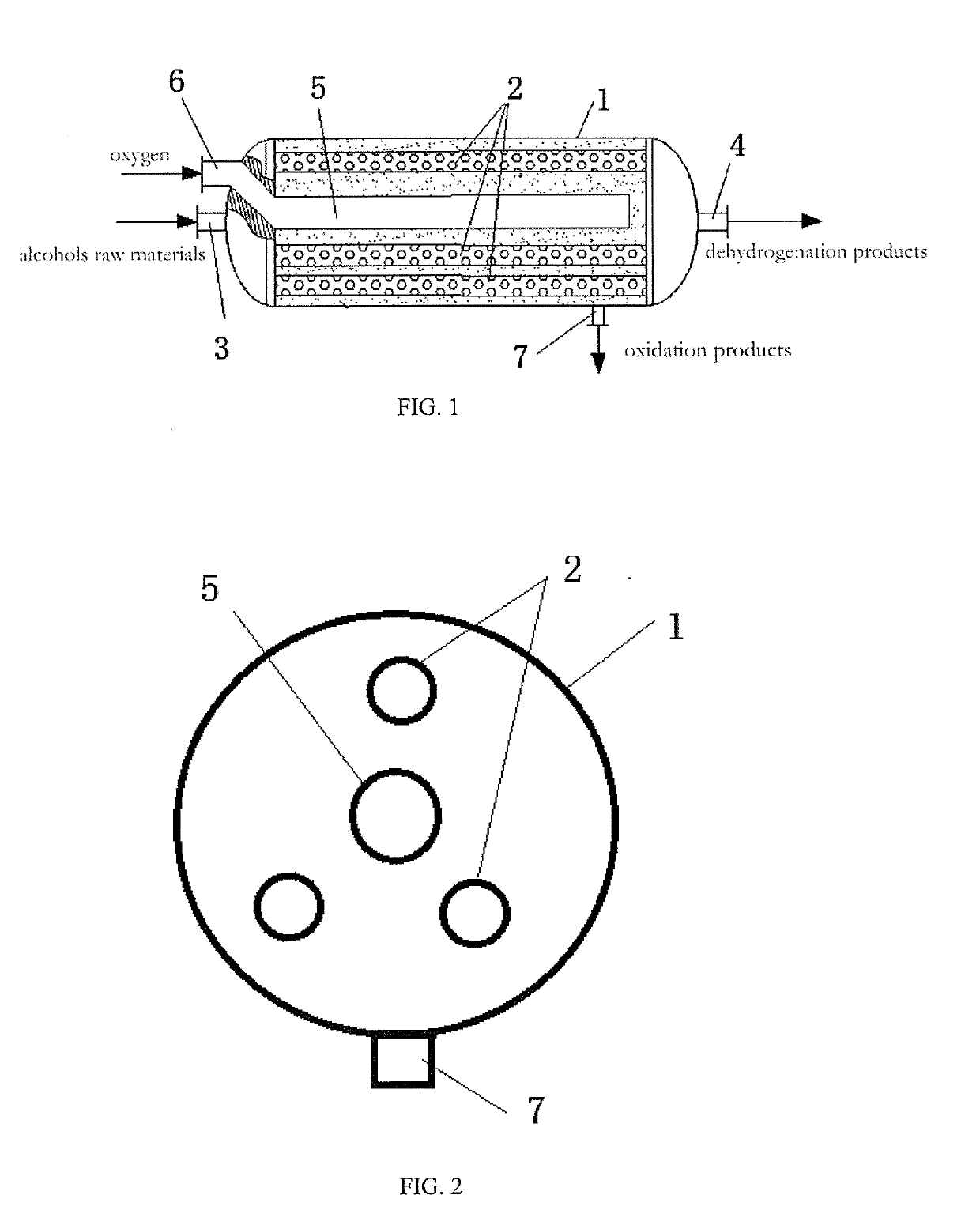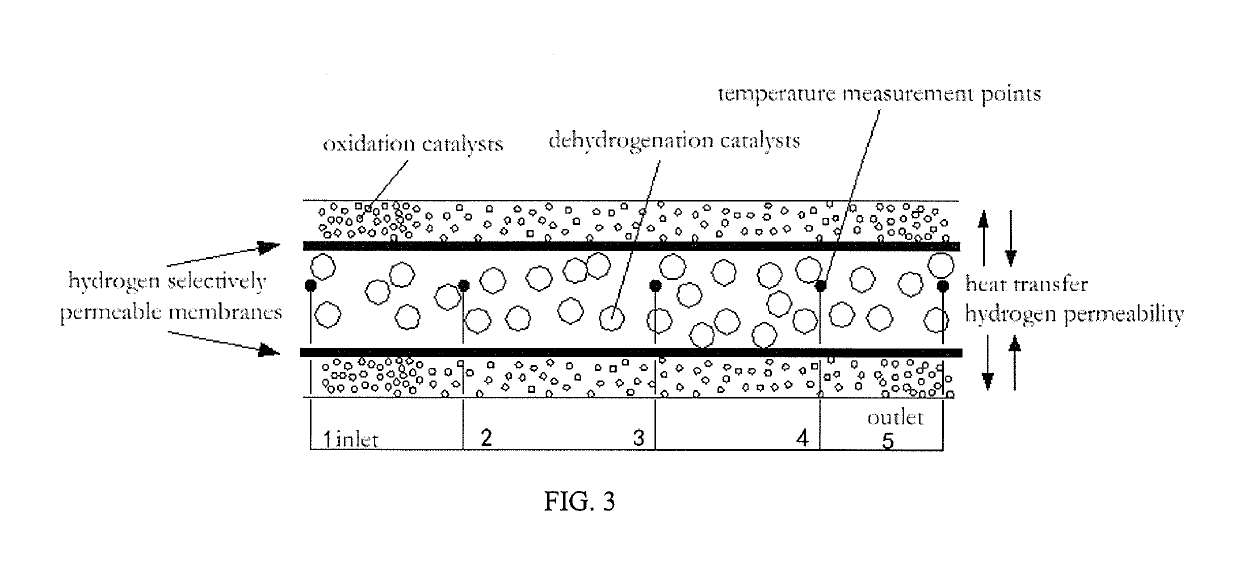Currently, there are two main methods for preparing carbonyl-containing compounds from alcohols, one is
catalytic oxidation method in which a carbonyl-containing compound is prepared by the combined action of an oxidant and a catalyst, but this method has many side reactions and may produce toxic and harmful wastes; the other one is catalytic dehydrogenation method in which
hydrogen is directly removed under the action of a catalyst, as the following reaction equation (1).
However, this method has strict requirements for catalysts, that is, catalysts are required for both the dehydrogenation process of alcohols and the
hydrogenation process of
hydrogen acceptors, and also the dehydrogenation and hydrogenation reactions are carried out in the same
system, leading to the difficulty in setting
process conditions.
In a homogeneous catalytic
system, catalysts are generally active and
highly selective, but, the
system needs the addition of alkali, organic solvents and other adjuvants, resulting in the
corrosion to equipment and the difficulty in separation and recycling of catalysts; while a heterogeneous catalytic system avoids this problem and is
environmentally friendly.
The conventional alcohol dehydrogenation process is mainly carried out in a
fixed bed or
fluidized bed reactor, but the generation of product hydrogen may limit forward progress of this
reversible reaction.
Also, in most of the cases reported, hydrogen generated by reaction permeates from the inner side to the outer side of a membrane, and then is blown off by a purging gas or vacuumized to increase the
penetration rate, resulting in extra
energy consumption and need of handling measures.
Although this process utilizes the hydrogen-
oxygen reaction to provide heat for the dehydrogenation process, the Pb membrane serves as a catalyst for the reactions on the two sides and also serves for membrane separation, leading to high consumption of Pb membrane, which results in high cost and
low permeability, and also, the difficulty in molding the Pb membrane causes difficult match between
permeation rate and
reaction rate, resulting in poor effect.
However, in general, the temperature of dehydrogenation reaction is far higher than that of
hydrogenation reaction, as a result, the matching of the temperature of dehydrogenation reaction and the temperature of
hydrogenation reaction is a big challenge, and also, hydrogen permeated from dehydrogenation reaction side has a low pressure, the hydrogenation reaction is generally carried out under a relatively
high pressure, as a result, the reaction on hydrogenation reaction side is hard to take place.
Overall, although the use of membrane reactors in dehydrogenation reactions has become more common in recent years, they are preferably used for
gas phase dehydrogenation reactions using
palladium membranes or
palladium alloy membranes, and due to relatively
low permeability to hydrogen, high cost and difficulty in molding, such membranes are difficult to use in liquid phase reactions; also, in most cases, hydrogen generated by dehydrogenation reactions is blown off by a purging gas or vacuumized rather than fully utilized.
Even if treating hydrogen with hydrogenation reaction to implement
thermal coupling, the
patent application CN1189483A does not consider the dismatch of
reaction conditions for hydrogenation and dehydrogenation reactions in industrial applicability, and barely discusses the control of
thermal coupling process; furthermore, in terms of industrial applicability, in the case of using the recently reported
single tube for dehydrogenation reactions, it is difficult to improve the yield, thereby affecting the benefits of plants.
1. Instead of adopting the
oxygen feeding method provided in
patent application CN1164523A, the present application adopts the method of feeding
oxygen via the selective membrane tubes, which is advantageous in that oxygen permeates to the oxidation side more uniformly, and also, different amounts or activities (implemented by preparing different
platinum loading amounts) of oxidation catalysts are filled in different positions to avoid the problem of failure in controlling the heating amount in each position within the reactor, thereby achieving good matching between heating amount and heat absorption amount at each point within the reactor; further, the use of this method for oxygen feeding solves the problem that hydrogen easily reaches the explosion limit on the oxidation side.
2. As dehydrogenation is implemented by liquid
phase reaction and hydrogen generated and another feed of oxygen are both in the
gas phase, the membrane material is selected from a variety of ranges, and easy to have high permeability and
high selectivity. The membrane used in the invention is preferably a porous inorganic membrane. At present studies,
palladium membranes are generally used for gas phase catalytic processes, bringing about the problems of poor permeability, high cost and difficulty in molding, however, owing to the
rational design of pore size, porous inorganic membranes can achieve good selective permeability to hydrogen and oxygen, with relatively low industrial manufacturing cost and convenience in molding.
3. Most of alcohol dehydrogenation reactions are reversible, with relatively low equilibrium conversion rate. Based on the principle of
reversible reaction, the forward progress of dehydrogenation reactions can be accelerated after removing the product hydrogen, therefore, the conversion rate of dehydrogenation reactions can be improved by removing the product hydrogen using the hydrogen selectively permeable membrane, thereby improving the yield of carbonyl-containing compounds; the removal of hydrogen upon reaction on the oxidation side is favorable to reduce the
hydrogen partial pressure and improve the driving force for inner-membrane hydrogen permeability.
4. In the alcohol dehydrogenation reaction using the
membrane reactor, the heat required for this reaction is supplied by hydrogen on the oxidation side, which has a low temperature and is convenient to control as compared to
combustion, and also, since the heat generated by
hydrogen oxidation is far more than the endothermic heat for dehydrogenation, the heat required for dehydrogenation reaction is supplied by controlling the addition amount of oxygen on the oxidation side and changing the activity of the catalyst in industry, thereby ensuring in situ heating and reducing
energy consumption; furthermore, the product on the oxidation side is the mixture of hydrogen and water, and after simple operation of water removal, hydrogen can be recycled for other processes.
5. Different catalysts are respectively used on the two sides of the membrane to ensure the rate and selectivity of dehydrogenation reaction, as a result, as compared to the use of membranes having
catalytic effect, this method can better control the progress of dehydrogenation reaction; also, the liquid phase dehydrogenation reaction and the gas phase oxidation reaction take place on the inner side and outer side of the membrane of the reactor, respectively, which is more easy to implement in industry.
6. The membrane used in the dehydrogenation reaction
membrane reactor is a multitubular membrane
assembly which, in terms of industrial applicability, has higher production efficiency and a more compact structure as compared to the
single tube membrane reactor, and which integrates double functions, that is, serving as a reactor, and a
heat exchanger for dehydrogenation reaction and oxidation reaction.
 Login to View More
Login to View More 


